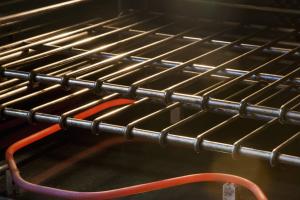How to Change the Heating Element in an Electric Oven: A Complete Guide

-
Quick Links:
- Introduction
- Understanding Heating Elements
- When to Replace Your Heating Element
- Tools and Materials Needed
- Step-by-Step Guide to Changing the Heating Element
- Common Issues and Solutions
- Case Studies
- Expert Insights
- FAQs
Introduction
Changing the heating element in an electric oven is a crucial skill for anyone who enjoys cooking at home. A malfunctioning heating element can lead to uneven cooking, undercooked meals, or even total cooking failure. This comprehensive guide will take you through the entire process of identifying, removing, and replacing the heating element in your electric oven, ensuring your culinary adventures can continue smoothly.
Understanding Heating Elements
The heating element in an electric oven is responsible for generating heat, which is essential for cooking food. There are generally two types of heating elements:
- Bake Element: Located at the bottom of the oven, this element is primarily used for baking.
- Broil Element: Located at the top of the oven, this element is used for broiling food.
Understanding how these elements work will help you diagnose issues effectively.
When to Replace Your Heating Element
Knowing when to change your heating element can save you time and frustration. Look for these signs:
- Food is not cooking evenly.
- The oven takes longer than usual to preheat.
- You see visible damage or burn marks on the element.
- The oven does not heat at all.
Tools and Materials Needed
Before you begin the replacement process, gather the following tools and materials:
- Screwdriver (Phillips or flat-head, depending on your oven model)
- Replacement heating element (ensure compatibility with your oven)
- Multimeter (for testing the old element)
- Safety gloves
- Cleaning cloth
Step-by-Step Guide to Changing the Heating Element
Follow these detailed steps to replace your oven's heating element:
Step 1: Safety First
Before starting any repair, ensure your oven is unplugged to avoid electrical shock.
Step 2: Remove the Oven Racks
Take out all oven racks to give yourself ample space to work.
Step 3: Locate the Heating Element
Identify whether you are replacing the bake or broil element. The bake element is usually at the bottom, while the broil element is at the top.
Step 4: Remove the Old Heating Element
Unscrew the heating element from its mounting. Carefully pull the element out, ensuring not to damage any wiring.
Step 5: Test the Old Element (Optional)
If you're interested in diagnosing the old element, use a multimeter to check for continuity. If it shows no continuity, it’s time to replace it.
Step 6: Install the New Heating Element
Insert the new heating element into place, ensuring it fits securely and the wiring is connected properly. Tighten it with screws.
Step 7: Reassemble the Oven
Replace the oven racks and ensure everything is in order.
Step 8: Test the Oven
Plug the oven back in and run a test to check if the new heating element is functioning properly.
Common Issues and Solutions
Even after replacing the heating element, you may face some issues. Here are common problems and their solutions:
- Oven still not heating: Check the power supply and ensure the oven is correctly plugged in.
- Uneven heating: Ensure the element is not obstructed by cookware.
- Burnt smell during the first use: This is normal as oils from manufacturing may burn off.
Case Studies
Consider the situation of Jane, a home cook who noticed her oven was taking longer to bake cookies. After troubleshooting, she found the bake element to be faulty. Following the steps outlined in this guide, she successfully replaced it and enjoyed perfectly baked cookies within an hour.
Expert Insights
According to appliance repair experts, regular maintenance of your electric oven can prolong its lifespan. They recommend checking the heating element periodically for signs of wear and tear, ensuring that it remains in good working condition.
FAQs
1. How do I know if my heating element is broken?
Signs include uneven cooking, longer preheating times, or visible damage to the element.
2. Can I replace the heating element myself?
Yes, with basic tools and safety precautions, you can replace the heating element yourself.
3. What if my oven still doesn't heat after replacing the element?
Check the power supply and consult an appliance repair technician for further diagnosis.
4. How often should I replace my heating element?
It varies, but generally, heating elements can last several years with proper care. Replace them when you notice performance issues.
5. Are there different types of heating elements?
Yes, there are bake elements and broil elements, each serving different functions in the oven.
6. What tools do I need for the replacement?
You’ll need a screwdriver, a replacement heating element, a multimeter, safety gloves, and a cleaning cloth.
7. Is it safe to use my oven while waiting for a new element?
No, it is unsafe to use the oven if the heating element is broken. It’s best to wait until it is replaced.
8. How can I extend the life of my oven’s heating element?
Avoid overheating the oven and regularly clean the interior to prevent grease buildup that can affect performance.
9. Can I use any heating element for my oven?
No, you should use a replacement element that is compatible with your specific oven model.
10. Where can I buy a replacement heating element?
You can purchase a replacement heating element from appliance repair stores, online retailers, or directly from the manufacturer.
Random Reads
- Mastering galaxy gyroscope calibration
- Mastering formica cutting
- How to safely clear cached files on your mac
- How to unlock toadette mario kart wii
- How to set up 2 step verification in gmail
- How to start a gas furnace
- How to stain stairs
- Unlock android without google account
- Mastering pokemon fire red gym leaders
- Mastering pokemon ruby beat elite four